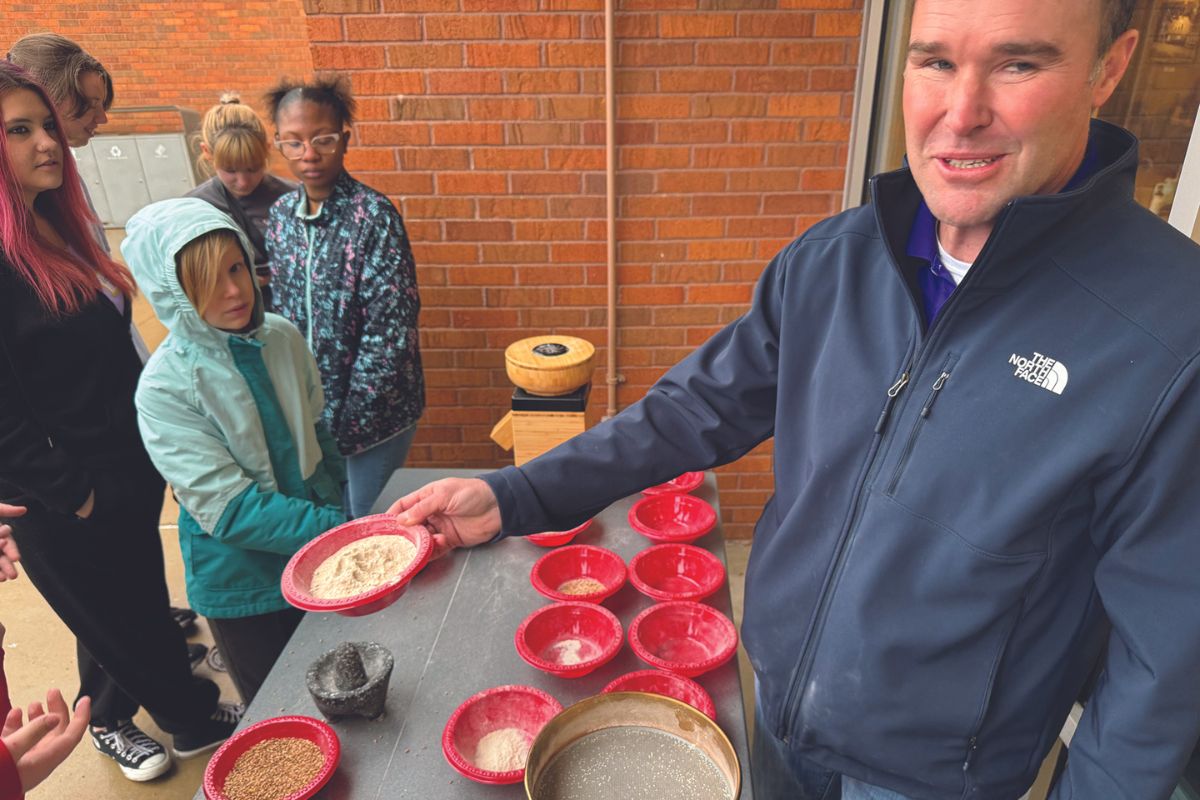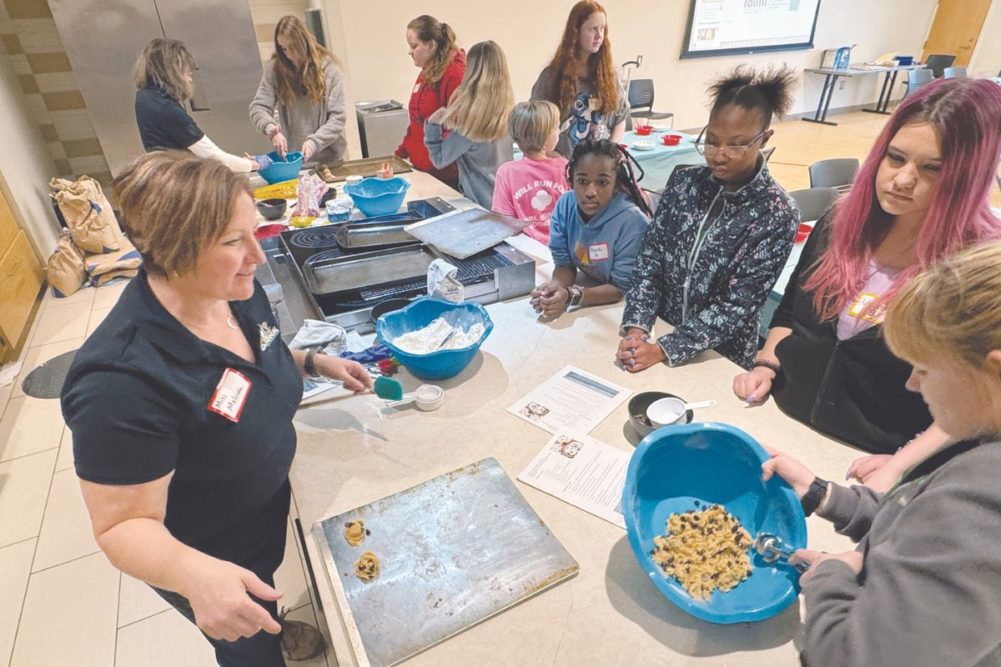BRENTWOOD, MISSOURI, US — Like many young teenage girls, Aria Pelikan’s knowledge of flour centered eating and making baked foods.
But after participating in a special flour milling program with Girl Scouts, in collaboration with the milling industry and the International Association of Operative Millers (IAOM), the 15-year-old now understands about the different types of flours and their uses, what products contain flour and how the milling process has evolved.
“We learned about the history of creating flour and how you have to sift it to get all the parts that you don’t want to eat out of your flour,” Pelikan said after the “Flour Rangers! Milling Flour for Girl Scout Cookies” program on Jan. 27.
Pelikan and nearly 100 other scouts, from kindergarten through 12th grade, participated in the program offered to the Girl Scouts of Eastern Missouri, at the Brentwood Community Center in Brentwood, Missouri, US. They earned the organization’s first flour milling patch.
And while the 15-year-old high school freshman in the Frances Howell School District in O’Fallon, Missouri, US, doesn’t plan on a career in milling, it sparked a new interest.
“It’s been interesting learning about it, and I enjoy baking, so this helped,” Pelikan said.
We have been trying to find ways to increase awareness about the industry because we know it’s a great place to build a career.
Raising awareness of the milling industry is a focus for the IAOM, said Melinda Farris, chief executive officer.
“We have been trying to find ways to increase awareness about the industry because we know it’s a great place to build a career,” she said. “We also know there is a lot of need for a more diverse workforce, and so we are working with the Girl Scouts because it’s a great new audience to introduce flour milling to.”
Mill employees from Ardent Mills and Miller Milling flew in from Minnesota and Texas to participate in the program, and were joined by a Kansas State Univeristy student and IAOM headquarters staff.
Materials were donated by Ardent Mills, KSU and Miller Milling. The Flour Rangers! program was sponsored by Ardent Mills, Grain Craft and IAOM.
Flour milling 101
Through a series of stations and hands-on activities, the girls learned about the milling process from field to fork. Dana Edwards, quality manager, Ardent Mills, Saginaw, Texas, US, and Jaley Walter, inside sales representative, Ardent Mills, Minneapolis, Minnesota, US, showed the girls examples of different wheat varieties and explained which types of products they are generally used for.
They also had pictures of various products and asked the girls which contained flour. Some were obvious, like bread and pasta, while others were not, such as Twizzlers licorice candy.
“It’s been so impactful to educate at this age group; I’ve been really inspired,” Edwards said. “They are very ambitious, and it’s been great to see that energy from them. They’re ready to conquer the world.”
With the help of Farris and other IAOM and Girl Scout staff, the girls baked chocolate chip cookies with all-purpose and high-protein flour, seeing firsthand how the high-protein flour resulted in denser, chewier cookies. They can apply what they learned immediately into their daily lives.
“They can go to the grocery store, look at the products and know flour is in this,” said Angie Miller, vice president sales, Ardent Mills, Marine, Illinois, US. “They can answer questions on types of flours and the end products. They’re really learning a lot.”
Other hands-on activities included a gluten washing station and milling methods, demonstrated outside by Eric Knott, plant manager, Miller Milling, Saginaw. Knott let the girls try extracting flour from hard red spring wheat using a mortar and pestle. Next, they had a go with a hand grinder, which simulated the improvement in technology with water-powered mills. Finally, Knott demonstrated an electric grinder, representing the technology available in mills today.

Eric Knott, plant manager, Miller Milling, lets the girls try their hand at making flour with a mortar and pestle, hand crank and electric grinder.
|“We learned how the process has changed over time and what people are doing now in mills versus what they did thousands of years ago,” Pelikan said. “It’s a lot better than it used to be. We got barely an ounce of flour just (using a mortar and pestle), and then the hand grinder produced about three ounces. The electric grinder produced a whole lot more flour.”
Knott tied his demonstration back to where the girls live by explaining how they’ve likely driven past one of the many large flour mills located in the St. Louis region. Ardent Mills, ADM and Italgrani all have facilities around St. Louis/Alton, Illinois.
“They are very large structures here in the community and no one knows what goes on inside, or how much flour it produces or how it services the community,” he said, adding that there is an opportunity to educate the next generation about the careers in the grain industry, whether it’s milling, baking or food, in the St. Louis area.
Even with multiple mills nearby, flour milling is something most, if not all, of the participants had been exposed to, said Natissia Small, CEO of Girl Scouts of Eastern Missouri.
“How neat for them to be able to put their hands in and understand those tangible experiences that go with flour milling,” she said. “This fits into the STEM world, which is where we most definitely want to elevate the number of girls and women. What we love is sparking their curiosity.”
Creating interest
We hope we’re inspiring these girls to one day seek out an opportunity in our industry. We hope that they learn a lot today and they develop a passion for this wonderful science that this industry is all about.
Industry leaders hope that kind of curiosity can eventually be transformed into a milling career.
“We hope we’re inspiring these girls to one day seek out an opportunity in our industry,” Miller said. “We hope that they learn a lot today and they develop a passion for this wonderful science that this industry is all about.”
Developing interest at a young age is critical, because the industry starts at a deficit position where few know anything about flour milling, Farris said.
“The sooner you can at least get it on their radar, that this is an opportunity, is important,” she said. “We want to bring awareness to the fact that something happens as it transforms from wheat into the flour they see in the grocery store.”
Attracting more women to the male-dominated industry is also important, Walter said.
“As time goes on there are more and more women getting involved,” she said. “I think it’s important we show them all these different career paths.”
The need for the next generation of workers in the milling industry is dire, Farris said. Ideally, IAOM would like to expand the Girl Scouts program to other regions and to other groups, organizations and even milling companies.






